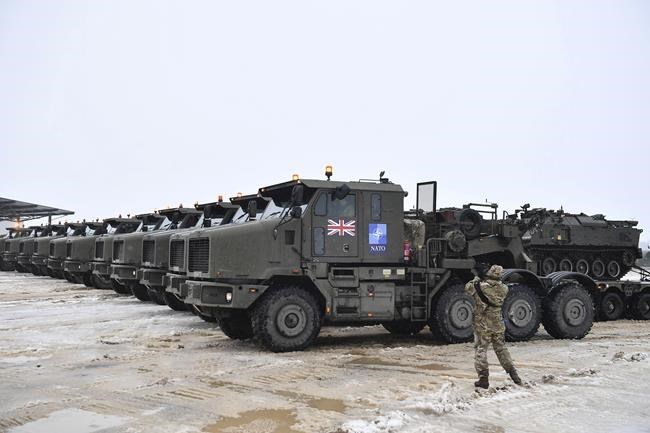BRUSSELS (AP) ŌĆö U.S. President Joe Biden and his NATO counterparts agreed Friday to send thousands of troops, backed by air and naval support, to protect allies near Russia and Ukraine in response to President Vladimir PutinŌĆÖs
Speaking after chairing a NATO summit, Secretary General Jens Stoltenberg said the 30-nation organization will send parts of the NATO Response Force and elements of a quickly deployable spearhead unit to the allianceŌĆÖs eastern flank. ItŌĆÖs the first time the force has been used to defend NATO allies.
Stoltenberg did not say how many troops would be sent or where they might go, but he did confirm that the move would involve land, sea and air power.
In response to EuropeŌĆÖs biggest security crisis in decades, Stoltenberg said, ŌĆ£We are now deploying the NATO Response Force for the first time in a collective defense context. We speak about thousands of troops. We speak about air and maritime capabilities.ŌĆØ
ŌĆ£There must be no space for miscalculation or misunderstanding. We will do what it takes to protect and defend every ally, and every inch of NATO territory,ŌĆØ he said.
The NRF can number up to 40,000 troops, but Stoltenberg said that NATO would not be deploying the entire force. Parts of a spearhead unit known in NATO jargon as the Very High Readiness Joint Task Force, which is currently led by France, will also be sent.
The announcement came after NATO members, ranging from RussiaŌĆÖs neighbor Estonia in the north down around the west of conflict-hit Ukraine to Bulgaria on the Black Sea coast, triggered urgent consultations Thursday about their security amid concerns from .
ŌĆ£We will continue to take all measures and decisions required to ensure the security and defense of all allies," the leaders said in a statement. ŌĆ£We will make all deployments necessary to ensure strong and credible deterrence and defense across the alliance, now and in the future.ŌĆØ
The worldŌĆÖs biggest security organization previously had around 5,000 troops stationed in ŌĆö Estonia, Latvia and Lithuania ŌĆö and Poland, but has significantly beefed up its defenses over the past three months.
Germany said Friday that it plans to deploy troops and a Patriot anti-missile system to Slovakia, which is a member of NATO and one of the countries to have triggered the urgent consultations, as part of an ŌĆ£enhanced vigilance activity battlegroup.ŌĆØ
NATOŌĆÖs Supreme Allied Commander in Europe, U.S. General Tod D. Wolters, said the new contributions ŌĆ£represent a flexible, combat credible force that can be employed in multiple ways and we are utilizing fully their inherent agility.ŌĆØ
He also thanked the U.S. and Canada for recent commitments to deploy an extra 7,640 troops, including an armored brigade combat team, artillery units, a naval frigate, and surveillance aircraft. It was not immediately clear whether those troops were part of the NRF deployment.
Some of NATOŌĆÖs 30 member countries are supplying arms, ammunition and other equipment to Ukraine, but NATO as an organization isnŌĆÖt. It wonŌĆÖt launch any military action in support of Ukraine, which is a close partner but has no prospect of joining.
The Baltic members, however, have said the West should ŌĆ£urgently provide Ukrainian people with weapons, ammunition and any other kind of military support to defend itself as well as economic, financial and political assistance and support, humanitarian aid.ŌĆØ
NATO began beefing up its defenses in northeastern Europe after Russia annexed UkraineŌĆÖs Crimean Peninsula in 2014. Recently, some members have also sent troops, aircraft and warships to the Black Sea region, near allies Bulgaria, Romania and Turkey.
Short-term, NATO has also activated an emergency planning system to allow commanders to move forces more quickly. Surveillance aircraft have also begun patrols inside allied territory.
As the leaders prepared for their virtual summit, pro-Ukraine demonstrators rallied outside NATOŌĆÖs headquarters in Brussels. Dozens of Ukrainians living in the Belgian capital chanted ŌĆ£Putin, Terrorist,ŌĆØ ŌĆ£Close the Sky DownŌĆØ and ŌĆ£Stop Putin, Stop War.ŌĆØ
ŌĆ£We are fighting for the whole democratic world here. If we donŌĆÖt stop them in Ukraine, they will go next to the European Union. They will be at your door,ŌĆØ said Artemii Sattarov, draped in a Ukrainian flag. That is why we are asking here to close the (airspace), to provide military help to Ukraine.ŌĆØ
___
Video reporter Mark Carlson in Brussels and Geir Moulson in Berlin contributed.
___
Follow APŌĆÖs coverage of the Ukraine crisis at
Lorne Cook, The Associated Press


